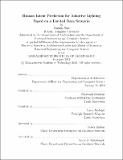Human intent prediction for adaptive lighting based on a limited data scenario
Author(s)
Sun, Jiamin (Researcher in architecture), author.
Download1373694303-MIT.pdf (7.265Mb)
Other Contributors
Massachusetts Institute of Technology. Department of Architecture.
Massachusetts Institute of Technology. Department of Electrical Engineering and Computer Science.
Advisor
Christoph Reinhart and Larry Rudolph.
Terms of use
Metadata
Show full item recordAbstract
An adaptive environment involves various ubiquitous computing and computer-aided technologies. It provides users with environmental supports such as lighting, air conditioning, motion assistance. Among the different control schemes, lighting is an essential element because it strongly affects people's visual experience and work productivity. The generalized residential lighting system is limited to create a personalized and responsive environment. Additionally, multiple and complex light sources make it difficult for users to obtain optimized lighting configurations. In general, an intelligent control system requires an extensive database of user habits in order to infer different user intents. In this work, we present a new personalized lighting control method that can learn explicit and implicit context though knowledge-based background and interactions. Instead of collecting a large amount of personal data, we explore the possibility to achieve a valid control method based on a limited data scenario. We consider language as one of the most important inputs from users when they are interacting with a smart environment. Although there has been a large amount of work in automatic control based on speech recognition, the situation is different for using language to control lights according to different preferences. In our study, on the one hand, multiple dimensions of representation of lighting status are studied and organized in a way that can be derived from people's language input. We have generated a learning model and a small database based on the hierarchy of different lighting settings. On the other hand, besides the learning part, we explore how users can directly teach the lighting system. That is, through continuous interactions, the control system learns users' profiles through limited interaction data and gradually becomes consistent with specific personal preferences. In addition to lighting control methods, we also introduce the different components of typical lighting systems and networks. This work contributes to fundamental knowledge in the areas of ubiquitous computing and home automation.
Description
This electronic version was submitted by the student author. The certified thesis is available in the Institute Archives and Special Collections. Thesis: S.M. in Architecture Studies, Massachusetts Institute of Technology, Department of Architecture, 2019 Thesis: S.M., Massachusetts Institute of Technology, Department of Electrical Engineering and Computer Science, 2019 Cataloged from student-submitted PDF of thesis. Includes bibliographical references (pages 75-80).
Date issued
2019Department
Massachusetts Institute of Technology. Department of Architecture; Massachusetts Institute of Technology. Department of Electrical Engineering and Computer SciencePublisher
Massachusetts Institute of Technology
Keywords
Architecture., Electrical Engineering and Computer Science.